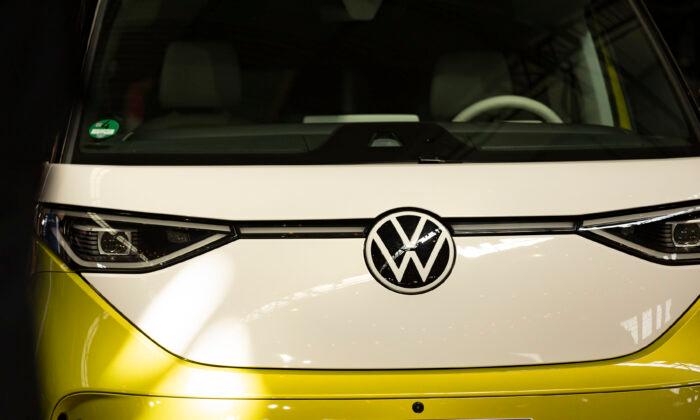One of Ottawa’s biggest selling points for its record subsidy to Volkswagen—which could top $13 billion—is the potential creation of tens of thousands of jobs. But leading public policy expert Jack Mintz is highly skeptical and also questions how the feds project to cover the cost of the new gigafactory in under five years.
The plant, in St. Thomas, Ontario, will generate about $200 billion in value and will be the largest manufacturing plant in Canada, according to the government’s April 21 news release.
At a news conference in the southwestern Ontario city, Prime Minister Justin Trudeau said, ”Yes, this investment is a big one,” adding that it was part of a strategic vision taken to invest in the battery and auto-making supply chain in Canada.
Mintz, president’s fellow at the University of Calgary’s School of Public Policy, said in an interview that there’s already more jobs available in Canada’s economy than there are workers to fill them, and when the government has to pay for these subsidies, that’ll mean higher taxes.
“So what is the net job creation? I suspect very little, to be frank, because you’re just drawing from other sectors of the economy. And to the extent that taxes have negative impacts on economic growth, this could actually lead to lower job creation—not higher job creation—as a result of carrying out this kind of subsidy,” he said.
Industry Minister François-Philippe Champagne, when asked by reporters on April 20, did not explain how the cost of the subsidy to the German car giant will pay for itself in less than five years.
Mintz says he thinks Ottawa’s projection comes from a narrow view of the situation, in that the government will get taxes from the gigafactory and maybe save on unemployment insurance.
“This is a very partial look at it paying for itself,” he said.
But he cautions that he’d have to see what the calculations actually are.
Industry Canada media relations was not able to provide answers by publication time to an inquiry from The Epoch Times on how the subsidies are to be recovered within five years, nor were they able to say how the potentially $13 billion is accounted for in the budget or possibly via the Canada Growth Fund.
Industry Canada officials told senators at the April 25 Senate national finance committee that taxpayers will only learn the terms of the VW deal once the money has been spent, according to Blacklock’s Reporter.
It’s not clear, based on Industry Canada’s responses to the committee, how the potentially $13 billion subsidy has been accounted for in the budget or whether it’s additional spending that will worsen the deficits.
Borrowing Jobs
It’s one thing to take advantage of the energy transition, but there are other growth areas in the Canadian economy, Mintz said.
“What we could be doing is imperilling growth in other parts of the economy, which is why I always argued governments should take on a more neutral approach.”
The Commons Standing Committee on Industry and Technology on April 24 voted in favour of holding a confidential meeting to review the contract for the VW deal, where Champagne would be invited to appear and respond to questions. According to the motion, MPs will only be permitted to view the contract in a secure environment with no phones or any other recording devices.
Other employment-related criticisms of the investment with VW stem from the amount invested per job created and what else could be done with that kind of money.
One example comes from the Canadian Taxpayers Federation (CTF), which says that if potential spinoff jobs are considered, the electric battery plant could create up to 8,000 jobs, which would cost taxpayers at least $1.6 million per job. The CTF says cutting taxes or building hospitals would be a better use of that money.
The government’s news release said the battery plant will create 3,000 direct jobs and up to 30,000 indirect jobs. Under this scenario, the cost per job created would be nearly $400,000.
The VW website described the 3,000 direct jobs as being “highly skilled,” but when asked by The Epoch Times whether the positions would include any R&D or if they’d be strictly manufacturing, the automaker did not respond.
‘Subsidy War’
Ottawa is trying to compete with the U.S. Inflation Reduction Act—the single largest climate investment in U.S. history, worth US$369 billion. Since it became law in August 2022, the feds have said that it will attract business investment away from Canada.
Business investment is vital for improving Canada’s weak productivity, non-inflationary growth, and standard of living.
The VW subsidy was structured to mimic what the Inflation Reduction Act offers, according to the feds.
“Biden has unleashed this subsidy war,” he said, adding that Ottawa has to seriously ask itself if it wants to play this game since what that entails is larger deficits and significant tax increases down the road.
“This is all one big gamble anyway,” he said. “You just don’t know where all these things are going to go over 30 years. Nobody can predict. So, the government’s taking big risks when they start picking winners and losers, because sometimes they can end up with a loser.”
He brought up the technology of hydrogen as an alternative to electric power. Ottawa is providing investment tax credits for this technology in Budget 2023.
Mintz notes that the auto industry keeps getting subsidized and when considering Canada’s flagging productivity, one must start asking serious questions.
Ottawa is not getting an equity stake for the VW deal as it did with the bailout of automakers during the financial crisis.





